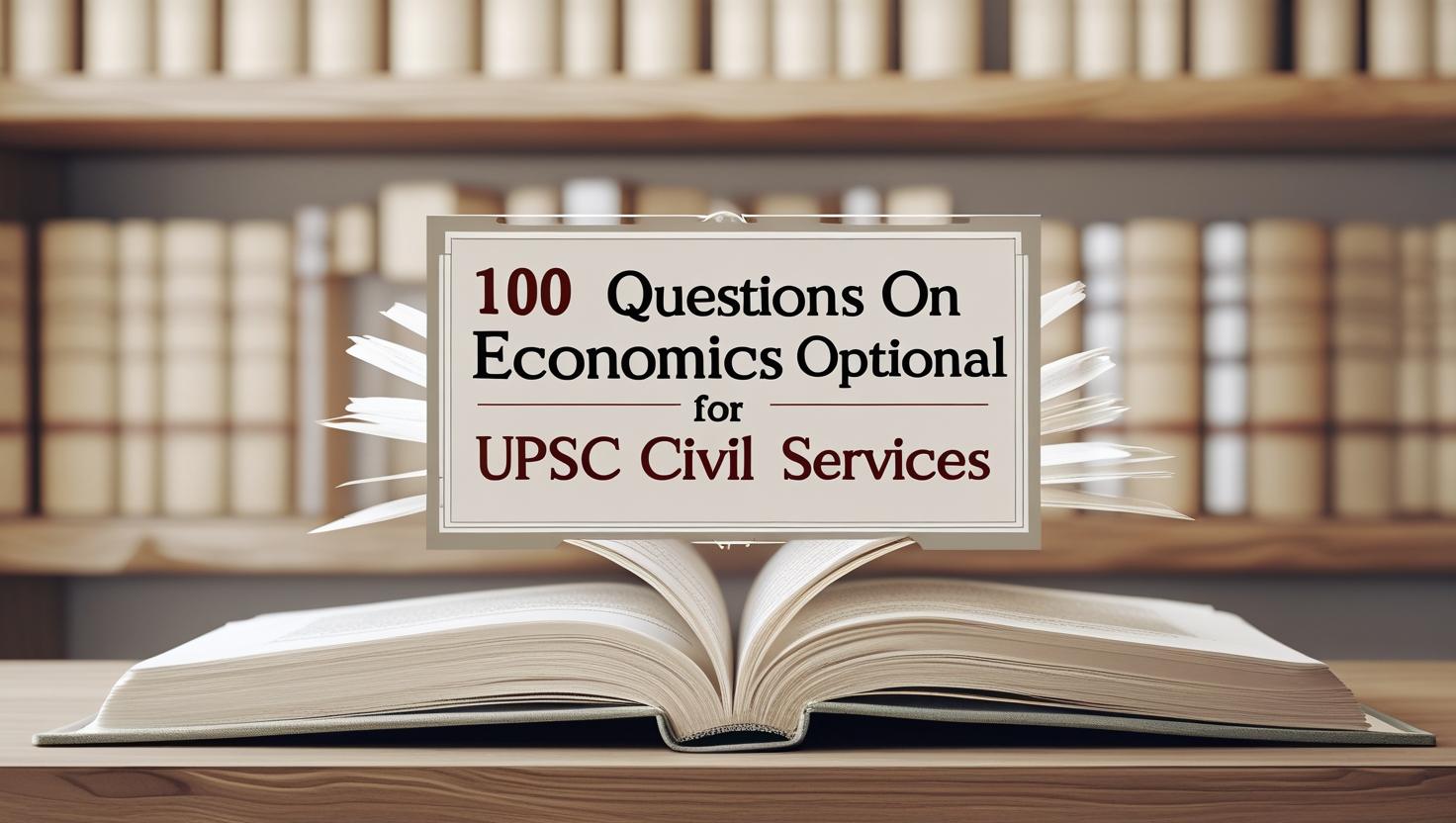Introduction
Economics is one of the most popular optional subjects in the UPSC Civil Services Examination. It covers both theoretical aspects and real-world applications, making it highly relevant for aspiring administrators. Below are 100 carefully structured questions divided into chapters according to the UPSC syllabus. These questions will help aspirants develop conceptual clarity and answer-writing practice.
For UPSC Coaching , Join FIRST IAS INSTITUTE (India’s Top IAS Coaching)
Chapter 1: Advanced Microeconomics
- Explain the law of demand and its exceptions.
- What is elasticity of demand and how is it measured?
- Discuss the concept of indifference curve analysis.
- Explain consumer equilibrium under Hicksian approach.
- What are the different types of price elasticity of demand?
- Discuss the concept of consumer surplus.
- Explain Slutsky equation and its applications.
- Differentiate between cardinal and ordinal utility.
- What are the conditions of producer equilibrium under perfect competition?
- Discuss the concept of returns to scale.
Chapter 2: Advanced Macroeconomics
- Explain the classical theory of employment.
- Discuss Keynesian theory of effective demand.
- What is IS-LM framework and its significance?
- Explain the concept of Phillips curve.
- What are the limitations of Keynesian economics?
- Discuss the role of money in macroeconomic analysis.
- Explain the concept of inflation and its types.
- What is stagflation? Discuss its causes.
- Explain natural rate of unemployment hypothesis.
- Discuss the concept of rational expectations in macroeconomics.

3: Money, Banking and Finance
- Explain the functions of money.
- Discuss the concept of high-powered money.
- Explain the process of credit creation by commercial banks.
- What is the role of RBI in controlling inflation?
- Explain the instruments of monetary policy.
- Discuss the concept of financial inclusion.
- What are non-performing assets and their implications?
- Explain Basel norms and their importance.
- Discuss the structure of the Indian financial system.
- What are payment banks and small finance banks?
Chapter 4: Growth, Development and International Economics
- Explain the Harrod-Domar growth model.
- Discuss Solow’s growth model.
- What is endogenous growth theory?
- Explain the concept of human capital in development.
- What are the determinants of economic growth?
- Discuss the role of institutions in economic development.
- Explain the concept of poverty traps.
- Discuss the difference between growth and development.
- Explain the role of international trade in economic development.
- Discuss the theory of comparative advantage.
Chapter 5: Public Economics
- Explain the concept of public goods.
- Discuss the principle of maximum social advantage.
- What are the sources of public revenue?
- Explain the incidence and shifting of taxation.
- Discuss the role of fiscal policy in economic development.
- Explain the concept of deficit financing.
- Discuss different types of government budget deficits.
- Explain the concept of debt sustainability.
- What is fiscal federalism in India?
- Discuss the recommendations of the latest Finance Commission.
6: Indian Economy – Planning and Development
- Discuss the objectives of Indian planning.
- Explain the achievements and failures of Five-Year Plans.
- What is NITI Aayog and its functions?
- Discuss the concept of mixed economy in India.
- Explain the role of public sector in Indian economy.
- Discuss the problem of unemployment in India.
- Explain the concept of disguised unemployment.
- What are the causes of poverty in India?
- Discuss the rural-urban income disparity in India.
- Explain the Green Revolution and its impact.
Chapter 7: Agriculture and Rural Development
- Explain the role of agriculture in Indian economy.
- What are the major challenges in Indian agriculture?
- Discuss the issue of agricultural productivity.
- What is agricultural price policy?
- Explain the significance of MSP.
- Discuss the impact of WTO on Indian agriculture.
- What are the causes of farmer distress in India?
- Explain the concept of land reforms.
- Discuss the role of NABARD in rural development.
- What is contract farming and its challenges?

Chapter 8: Industry and Infrastructure
- Explain the role of industry in economic development.
- Discuss the industrial policy of 1991.
- Explain the role of MSMEs in Indian economy.
- What are the challenges faced by Indian manufacturing sector?
- Explain the concept of Make in India.
- Discuss the significance of infrastructure in economic growth.
- Explain the role of power sector in Indian economy.
- What are the challenges in transport infrastructure?
- Discuss the issue of urbanization and its economic impact.
- Explain the role of IT industry in India.
9: External Sector and Globalisation
- Discuss India’s balance of payments situation.
- Explain the concept of exchange rate determination.
- What is foreign direct investment and its importance?
- Discuss the role of WTO in global trade.
- Explain the concept of current account deficit.
- What are Special Economic Zones and their significance?
- Discuss the impact of globalization on Indian economy.
- Explain the concept of trade protectionism.
- What are the major export items of India?
- Discuss the role of remittances in Indian economy.
Chapter 10: Current Economic Issues and Policies
- Explain the problem of unemployment post-COVID-19 in India.
- Discuss the issue of rising inequality in India.
- Explain the role of digital economy in India’s growth.
- What are the implications of GST on Indian economy?
- Discuss the challenges of climate change for Indian economy.
- Explain the concept of inclusive growth.
- What is Atmanirbhar Bharat Abhiyan?
- Discuss the significance of Startup India initiative.
- What are the challenges in achieving sustainable development goals?
- Explain the role of social security measures in India.
Conclusion
Economics as an optional subject requires both conceptual depth and an understanding of real-world applications. The above 100 questions are carefully curated to cover every aspect of the UPSC Economics Optional syllabus, from micro and macro theory to India’s development challenges and policy issues. Practicing these questions will help aspirants develop analytical skills and write comprehensive answers in the exam.
Also Visit – Best IAS Coaching in India
For Answer Writing Techniques – Join FIRST IAS INSTITUTE

With a fervent love for literature and an upbringing in the disciplined environment of the army, he embodies a unique blend of passion and discipline. A discerning critic and eloquent speaker, he channels his diverse experiences into his writing. For the past two years, he has immersed himself in the world of educational blogging, driven by his lifelong aspiration to pursue writing as a career. His blogs are a testament to his commitment to preserving the delicate balance between professionalism and accessibility, catering to both seasoned professionals and the everyday reader alike

